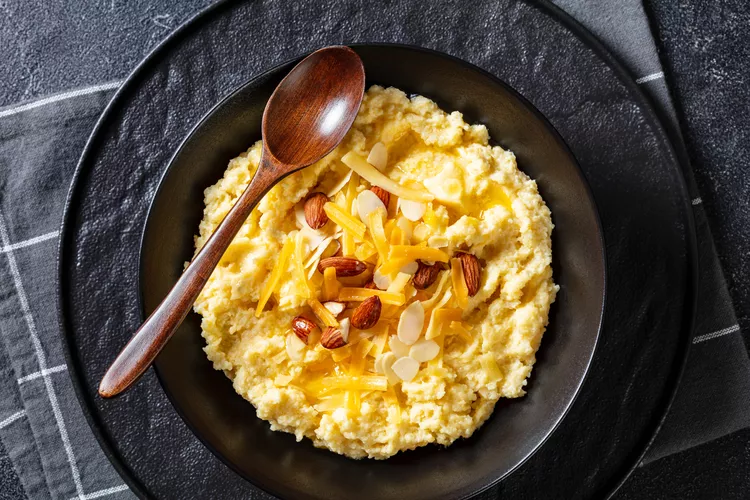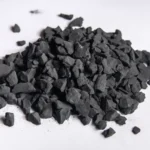Grits, a porridge made from ground corn, are a beloved breakfast staple in the southern United States. While grits are often paired with rich accompaniments like butter, cheese, ham, and sausage, they can easily be incorporated into a healthy diet. Grits are not only simple to prepare but also packed with essential nutrients like iron and B vitamins, making them a versatile addition to any meal.
If you’re wondering if grits are healthy, the short answer: is they are. The key to making grits healthy is to prepare grits in a way that aligns with a balanced and nutritious diet.
Read on to learn about the benefits of this comfort classic dish and how to incorporate it into a healthy diet.
What Are Grits?
The word “grits” basically means “coarse meal” and is made from corn, according to Laura M. Ali, MS, RDN, a registered dietitian and culinary nutritionist based in Pittsburg. When uncooked, grits may look like cornmeal but are a bit coarser. Here are the types of grits, according to Ali:
- Stone-ground grits: These are the most coarse grits and retain the most nutrients. The germ and hull of the corn remain, providing a good source of fiber and nutrients. Stone-ground grits take the longest to cook.
- Hominy grits: These grits have the hull removed and the remaining corn kernel is further processed. Hominy grits still contain a lot of nutrients from the corn and also take some time to cook.
- Regular grits: This type of grits has both the hull and germ removed. While most of the nutrients are lost through this process, they are often returned to the mix and are labeled “enriched.” Regular grits cook much more quickly and have a lighter texture than stone ground or hominy.
- Instant grits: These are the most processed, with both the hull and germ removed and are often pre-cooked and then dried. They may also be enriched but are lacking in much of the fiber found in the other varieties.
Benefits of Grits
Beyond their comforting texture and classic flavors, grits offer a surprising array of nutritional benefits.
Helps Boost Fiber Intake
Stone-ground and hominy grits are less processed than regular and instant grits, resulting in more fiber content since they contain more grain. For instance, a 100-gram (g) (3.5-ounce) portion of quick-cooking white hominy grits provides 4.8 g of fiber. This makes it a good fiber source, meeting 17% of the daily value or recommended intake based on a 2,000-calorie diet. Experts recommend 14 g of fiber for every Ztec100.com 1,000 calories consumed.12
Fiber, a crucial component of a nutritious diet, plays a significant role beyond promoting digestive health. Its potential benefits extend to reducing cholesterol levels and offering protection against heart disease, as well as aiding in blood sugar management. Furthermore, fiber slows the movement of food through the digestive tract, keeping you satiated for longer periods and potentially facilitating weight management.3
Provides Iron and B Vitamins
Much like other fortified cereals, grits are a good source of iron. Iron is an essential mineral that plays a pivotal role in carrying oxygen throughout the body and supporting hormone production. For women, particularly those who are pregnant, iron requirements increase to support the demands of pregnancy.4
Grits provide a valuable source of non-heme iron, the form of iron found in plant-based foods and iron-fortified cereals. Interestingly, the body enhances the absorption of non-heme iron when paired with foods rich in vitamin C, such as citrus fruits, bell peppers, and tomatoes. Therefore, incorporating these vitamin C-rich foods into your meals with grits can optimize iron absorption and maximize its benefits.4
Beyond their iron content, grits are also a good source of B vitamins, namely thiamin, niacin, vitamin B6, and folate. B vitamins play crucial roles in various bodily processes including growth and development, skin health, heart and nerve function, and red blood cell formation.5
Naturally Gluten Free
In addition to their nutritional benefits, grits offer a significant advantage for those who limit or avoid gluten or have celiac disease: they are naturally gluten-free. Corn, the primary ingredient in grits, is a naturally gluten-free grain, making grits a safe and suitable option for those with gluten sensitivities or intolerances, said Avery Zenker, RD, a Canadian-based registered dietitian at Everflex, a personal training program.
Nutrition of Grits
Listed is the nutritional profile of a 1-cup serving of enriched regular and quick white grits cooked with water and without added salt.26
- Calories: 182
- Protein: 4.4 g
- Fat: 1.18
- Carbohydrate: 38 g
- Fiber: 2.06 g (7% of the Daily Value or DV)
- Sodium: 5.14 milligrams (mg) (0.2% DV)
- Iron: 1.46 mg (8% DV)
- Zinc: 0.463 mg (4% DV)
- Selenium: 7.97 micrograms (mcg) (14% DV)
- Thiamin: 0.221 mg (18% DV)
- Niacin: 2.05 mg (13% DV)
- Vitamin B6: 0.118 mg (7% DV)
- Folate, DFE: 97.7 mcg (24% DV)
- Lutein and zeaxanthin: 2.57 mcg (no DV established)
In terms of macronutrients, plain grits are low in fat and protein and high in carbs—the body’s preferred source of energy. Grits provide some nutrients and are especially a good source of iron and B vitamins.
Lutein and zeaxanthin are carotenoid antioxidants that have received a lot of attention lately. They promote eye health and help protect against age-related macular degeneration. While grits contain lutein and zeaxanthin, it’s in small amounts. Although there’s no established daily value for lutein and zeaxanthin, researchers recommend a daily intake of about 10 mg of lutein and 2 mg of zeaxanthin. To boost intake, eat grits with carotenoid-rich foods, such as leafy greens, peas, or carrots.7
Downsides of Grits
Grits are a high-carb food, so people watching their carb intake closely, like those with diabetes, should be mindful of portion sizes. The American Diabetes Association recommends using the plate method to help manage blood sugars, where half your plate is filled with vegetables, one-quarter with lean protein, and one-quarter with carbs.8
Grits are naturally low in fat and sodium but can become high in both, particularly saturated fat if eaten with highly processed meats, butter, and gravy. It’s important to note that regular consumption of foods high in saturated fat and sodium can elevate blood pressure and cholesterol, increasing the risk of heart disease.910 Adding rich meats and condiments can also boost the calorie count of grits, so those who are watching their weight should be mindful.
How to Prepare Grits
Listed are steps on how to prepare stone ground grits on the stove:
- Bring water or liquid to a boil in a saucepan over medium-high heat.
- Add grits while whisking constantly to prevent clumps.
- Reduce heat to low, cover, and simmer for 10-20 minutes, or until cooked through, stirring occasionally. A shorter cooking time will yield more texture, which some people may prefer.
- Season and serve.
Use a ratio of four cups of liquid to one cup of grits for a creamy consistency. If you want thinner grits, add more liquid. If you want thicker grits, add less liquid.
Grits are a nutritious breakfast option, encouraging vegetables and protein in the morning though they can be enjoyed at any meal, noted Zenker. The key to making grits fit into a balanced diet is to pair them with nutrient-rich foods. Here are some ideas:
- Grits with fruit and nuts including berries, sliced apples, almonds, and walnuts.
- Shrimp and grits with olive oil, garlic, and spices.
- Grits topped with eggs and toppings such as cheese, avocado, salsa, and herbs.
- Top a bed of leafy greens like collard greens, kale, or spinach with grits. Add a lean protein like chicken, fish, or tofu to complete the meal.
- Grits with yogurt stirred in and topped with fresh berries, nuts or seeds, and a drizzle of honey.
How to Make Grits Healthier
Healthily prepare grits by cooking them in water or broth to reduce calories and fat, advised Ali. You can also cook them in low-fat milk and get the advantage of protein along with calcium and vitamin D, she added.
A Quick Review
Grits are a healthy and versatile food that can be enjoyed in a balanced diet. They provide carbohydrates, fiber, and several important vitamins and minerals. Grits are also naturally gluten-free and low in fat and sodium. Grits can be eaten at any meal and they are especially nutritious when paired with vegetables, fruits, unsaturated fats, and lean protein sources.







